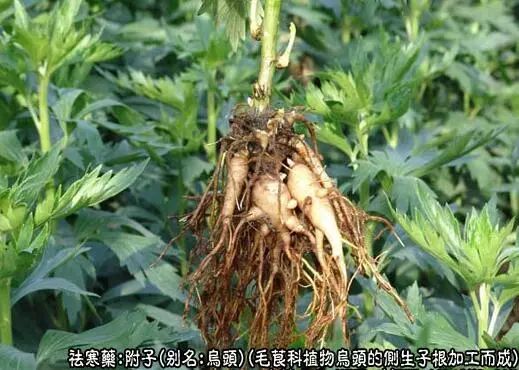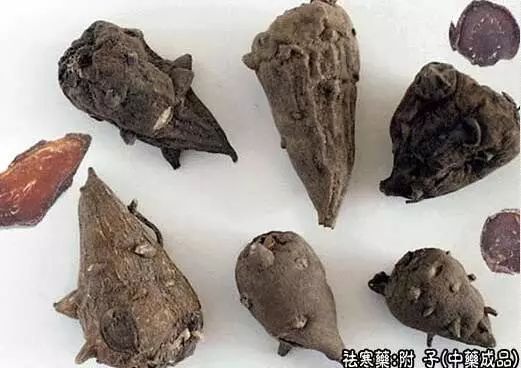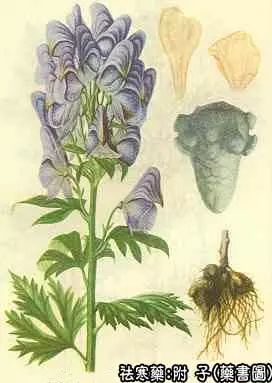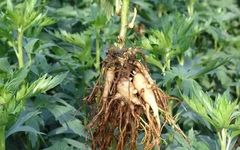Disease Inquiry, Health Guidance, Classic Health Preservation, Traditional Chinese Medicine and Herbs, No Need to Seek Help When Sick



Fu Zi (Aconite) is a commonly used traditional Chinese medicine, classified as inferior in the Shen Nong Ben Cao Jing (Shen Nong’s Classic of Materia Medica).
Aliases: Tian Xiong (Heavenly Hero), Wu Tou (Aconite), Fu Pian (Aconite slices), Yan Fu Zi (Salted Aconite), Hei Shun Pian (Black Aconite slices), Bai Fu Pian (White Aconite slices).
Source: Processed from the lateral roots of the Aconitum plant, a member of the Ranunculaceae family. The main root is known as Chuan Wu in Sichuan Province. All are cultivated.
Production Areas: Mainly produced in Jiangyou County and An County of Sichuan Province. Also produced in Shaanxi, Yunnan, and Hunan.
Harvesting and Processing: The roots of Aconite are dug up from late June (Summer Solstice) to early July (Minor Heat), cleaned of soil, and the lateral tubers are selected and called Ni Fu. They are then processed according to different specifications.
1. Salted Aconite: Select Ni Fu, wash it clean, and soak it in a solution of magnesium chloride (brine) and table salt for several days. Remove and air dry until semi-dry, then soak in magnesium chloride solution while continuously adding salt to maintain a supersaturated state. Repeat this process until salt crystals adhere to both the inside and outside of the Aconite, then dry.
2. Aconite Slices: Clean medium-sized Ni Fu, scrape off the outer skin, cut into two slices, soak in magnesium chloride solution for several days, boil for 2-3 minutes, then rinse with clean water. Use brown sugar and vegetable oil to make a coloring agent to dye it a dark tea color, then rinse with clean water until it no longer numbs the tongue, steam until cooked, and dry.
3. Black Aconite Slices: Clean small Ni Fu without scraping the outer skin, soak in magnesium chloride solution for several days, boil for 2-3 minutes, rinse with clean water, cut into 5mm slices, and dye with brown sugar and vegetable oil to a tea color. Rinse with clean water until it no longer numbs the tongue, steam until cooked, and dry.
4. White Aconite Slices: The processing method is similar to that of Black Aconite Slices, but the outer skin is scraped off without dyeing. Boil until transparent, dry until semi-dry, and then sulfur-fumigate to whiten, then dry.
Identification:
Salted Aconite is also known as Tian Xiong. It is conical in shape, about 4-8 cm long and 3-5 cm in diameter, with a brown or black-brown skin covered with salt crystals. The upper part has several nipple-like protrusions, the middle has raised supporting roots, and the tip has a slightly concave bud scar. Due to prolonged salting, it is heavy and not dry, easily split, with a cross-section showing gelatinized starch, yellow-brown in color, with a slightly lighter center showing star-like patterns. Salt crystals are also present in the voids, with a salty, slightly bitter, and spicy taste.
The best quality is characterized by being plump, firm, and dark gray in color.
Aconite Slices: Slightly smaller than Salted Aconite. The longitudinal cut surface has raised edges and a central depression. Both inside and outside are light brown or brownish-yellow, glossy, hard, and not easily broken. It appears semi-transparent when illuminated. The outer surface also has protrusions and scars. The taste is mild and flat.
The best quality is bright yellow in color, without mold, and uniform in size.
Black Aconite Slices: Irregularly shaped slices, about 3-4 mm thick. The outer skin is black-brown, and the inner color is brownish-yellow. The texture is hard and glossy.
The best quality is large, uniform slices, brownish-yellow in color, hard, and without white cores.
White Aconite Slices: The shape and taste are similar to Black Aconite Slices, but the entire body is light yellow-white.
The best quality is large slices, white, transparent, and uniform in thickness.
Toxicity: This product can easily cause poisoning if improperly processed or used in excessive amounts. Symptoms of poisoning include burning sensation in the mouth, numbness (starting from the fingers and spreading throughout the body), salivation, nausea, possible vomiting, fatigue, difficulty breathing, dilated pupils, irregular pulse (weak and slow), cold and sticky skin, pale complexion, and possible sudden death. Rescue methods include: 1-2% tannic acid for gastric lavage, appropriate use of emetics; activated charcoal (mixed with water); intravenous injection of glucose saline. Symptomatic treatment; timely use of stimulants such as Nikethamide; maintain warmth; provide oxygen or perform artificial respiration if necessary; subcutaneous injection of atropine if heart rate is slow and weak.
Processing: Aconite Slices: Black Aconite Slices and White Aconite Slices can be used directly as medicine.
Light Aconite Slices: Take Salted Aconite, soak in clean water, changing the water 2-3 times daily until the salt is removed, then boil with licorice and black beans until the taste is slightly numbing, remove, discard licorice and black beans, scrape off the skin, cut into two slices, and boil in water for about 2 hours, then dry and repeatedly moisten several times, cut into slices, and dry. (For every 100 jin of Salted Aconite, use 5 jin of licorice and 10 jin of black beans.)
Processed Aconite Slices: Take Salted Aconite, wash clean, soak in clean water overnight, remove the skin and navel, slice, soak until the taste is slightly numbing, then soak in ginger soup for 1-3 days, steam until cooked, and then dry until 70% dry, then stir-fry over high heat until smoke rises and it slightly bulges, then cool.
Main Components: Contains alkaloids, including aconitine, new aconitine, and mesaconitine, among others. Additionally, it contains non-alkaloid components.
Pharmacological Effects: This product has traditionally been believed to have the effects of reviving yang and rescuing from collapse, dispelling cold and alleviating pain.
1. Cardiotonic: It can enhance the contraction of the heart. In cases of collapse (shock, heart failure), the cardiotonic effect of Aconite improves overall circulation, thus rescuing cardiovascular insufficiency. The effective component is the non-alkaloid part, which is generally not destroyed by boiling and retains its cardiotonic effect.
2. Analgesic: Experimental evidence shows that the decomposition products of aconitine have a certain analgesic effect.
3. Anti-inflammatory: It has a significant anti-inflammatory effect on experimental arthritis (formaldehyde and egg white induced).
4. Stimulates the pituitary-adrenal cortex system: The decoction of processed Aconite significantly reduces the content of ascorbic acid in the adrenal glands of rats, increases the excretion of 17-ketosteroids in urine, and reduces the number of eosinophils in peripheral blood. Additionally, for some patients with adrenal cortical insufficiency, Aconite has adrenal cortex hormone-like effects.
Taste and Properties: Spicy, very hot, and toxic.
Meridians Entered: Enters the twelve meridians.
Functions: Revives yang and rescues from collapse, supplements fire and assists yang, dispels cold and eliminates dampness.
Indications: Used for internal excess of yin-cold, severe vomiting, diarrhea, and sweating, cold body and limbs, yang deficiency leading to collapse, weak pulse on the verge of disappearance. Cold pain in the waist and knees due to kidney yang deficiency, chronic diarrhea due to spleen yang deficiency, aversion to cold, and wind-cold-damp bi syndrome.
Clinical Applications: Aconite is only suitable for conditions of yin deficiency and overall functional decline. Reference indicators for using Aconite include: 1. Pulse is deep, slow, weak, or thin; 2. Aversion to cold, cold limbs, cold and aching waist and knees; 3. Clear and long urination, loose stools, increased frequency belonging to yang deficiency diarrhea; 4. Pale complexion, pale lips, frequent yawning, white greasy tongue with a plump texture. Additionally, the following conditions can be referenced: lower limb edema, drowsiness, spontaneous sweating. Based on these basic symptoms, combine with other syndromes for appropriate compatibility.
1. Treating yin syndrome edema (yin water): Any edema accompanied by symptoms of overall functional decline or failure belongs to yin water, commonly seen in edema caused by chronic nephritis and heart failure. At this time, the patient has significant symptoms of spleen and kidney yang deficiency, and using general diuretics alone cannot solve the problem. It is necessary to add Aconite, dried ginger, and other herbs to warm the kidney and dispel cold, warm the spleen and promote diuresis, and activate overall function (mainly blood circulation). Generally, it can be added to Wu Ling San (Five-Ingredient Powder) with dried ginger and Aconite, or use a warming yang diuretic decoction. If the spleen-qi strengthening effect is needed, then use dried ginger and Aconite with Bai Zhu (Atractylodes), licorice, Hou Po (Magnolia Bark), and Mu Xiang (Saussurea) in a formula like Shi Pi Yin (Real Spleen Decoction) (this formula is a representative formula for treating yin water). This formula is also applicable for cold-damp type ascites due to liver cirrhosis. After warming the kidney with Aconite, it can not only promote diuresis but also significantly improve appetite.
2. Treating yang collapse and reversal (shock and collapse), manifested as cold skin, weak breathing, cold limbs (reversal means cold but not warm), weak and thin pulse due to circulatory failure, Aconite, dried ginger, and ginseng should be used to warm yang and rescue from collapse (cardiotonic and anti-shock). For milder cases, use Aconite Decoction; for more severe cases, use Si Ni Decoction; for even more severe cases, use Shen Fu Decoction. If there is severe cold sweat, add Long Gu (Dragon Bone), Mu Li (Oyster Shell), and Wu Wei Zi (Schisandra) as well.
3. Treating yang deficiency and decline, especially kidney yang deficiency (insufficient Ming Men fire), with a cold feeling in the lower body, cold and aching waist and knees, cold pulling pain in the lower abdomen, frequent urination, and weak pulse. Commonly seen in patients with chronic diseases or elderly individuals. At this time, it is advisable to add Aconite to tonics for faster results. Combine with Shan Yu Rou (Shan Yao), Shu Di Huang (Rehmannia), as in the formula Fu Gui Ba Wei Wan (Aconite and Cinnamon Eight Flavor Pill), or combine with Du Zhong (Eucommia), Gou Qi Zi (Goji Berries), and Huai Shan (Chinese Yam) as in the formula You Gui Yin (Right Return Decoction).
4. Treating wind-cold-damp bi syndrome, especially in cases where cold is predominant in rheumatic arthritis, with significant pain that occurs with cold and is relieved by warmth, often accompanied by aversion to cold, cold limbs, white tongue coating, and thin wiry pulse, Aconite can be combined with Gui Zhi (Cinnamon Twig), as in Gui Zhi Jia Fu Zi Tang (Cinnamon Twig Decoction with Aconite).
5. Treating cold abdominal pain: Caused by spleen and kidney deficiency-cold, with bowel sounds and abdominal pain, gastric pain, vomiting clear water or phlegm, loose stools, cold hands and feet, and thin wiry pulse (can be seen in ulcer disease, gastrointestinal neurosis, chronic colitis, etc.), Aconite can be combined with dried ginger, Dang Shen (Codonopsis), Bai Zhu (Atractylodes), as in the formula Aconite Li Zhong Tang (Aconite Middle-Strength Decoction).
Additionally, Aconite can also be used to warm and transform cold phlegm. For phlegm-damp in the lungs with severe cold symptoms, often feeling cold in the back and having virtual cold cough (such as bronchial asthma, certain types of chronic bronchitis), in addition to using Ma Huang (Ephedra), Wu Wei Zi, and Ban Xia (Pinellia), sometimes Aconite is added to warm the kidney.
Precautions:
1. Avoid use in cases of yin deficiency and heat syndrome. Those with any of the following conditions should not use Aconite: 1. Pulse is full, rapid, or large; 2. Severe constipation; 3. High fever; 4. Internal heat with external cold, true heat and false cold; the above four conditions belong to heat syndrome. If Aconite is used inappropriately, it is like adding fuel to the fire, making it burn more fiercely, leading to symptoms such as bleeding from the mouth and nose, and even convulsions; 5. Patients with heart disease showing atrioventricular block should also avoid Aconite. General contraindications apply.
2. Aconite should be used cooked. Raw Aconite can easily cause poisoning. Aconite boiled for more than one hour reduces its cardiotoxic effects, but the cardiotonic effect is still preserved. Therefore, decoctions containing Aconite must be boiled for at least one hour.
3. Symptoms of Aconite poisoning include numbness of the limbs (starting from the fingers), dizziness and weakness, sweating, salivation, nausea, and more severe cases may include palpitations, arrhythmia, hypotension, convulsions, and coma. For mild cases, general treatment such as gastric lavage and warmth is sufficient; for more severe cases, atropine injection is required. Traditional Chinese medicine uses 120g of ginger, 15g of licorice, boiled in water, or 90-120g of mung beans, concentrated decoction, which has a certain detoxifying effect on mild poisoning cases.
4. Experiments have shown that licorice or dried ginger cooked with processed Aconite can reduce its toxicity. Therefore, ancient practitioners often used licorice and dried ginger with Aconite in warming agents, which has scientific basis, not only enhancing the warming effect but also reducing the toxicity of Aconite.
5. Traditionally, Aconite is avoided in combination with Bei Mu (Fritillaria), Gua Lou (Trichosanthes), Bai Qi (Radix et Rhizoma), Ban Xia, and Bai Lian (Nymphaea).
6. Aconite is generally better taken warm, although some suggest that those with extreme yang deficiency should take it hot (to enhance its yang-supporting effect), while those with lower body deficiency-cold and upper body false heat, with symptoms such as facial redness and agitation, should take it cold.
Dosage: The dosage of processed Aconite slices should not be too heavy to avoid poisoning. When used as a guide to enhance the effect of tonics, 1.5-4.5g is sufficient; for cardiotonic and warming effects, 4.5-9g. In cases of shock and collapse, large doses may sometimes reach 18-20g, or even 30g, but must be administered by an experienced physician. In some regions, habitual users of Aconite may take 30-90g (but must be thoroughly processed), which may relate to individual tolerance to Aconite, but should never be considered a standard dosage. In summary, the common dosage of processed Aconite slices is 3-9g.
Storage: Salted Aconite should be stored in a cool, dry place, sealed; Black Aconite slices and White Aconite slices should be stored in a dry place, protected from moisture.
Example Formulas:
1. Zhen Wu Tang (True Warrior Decoction) (Shang Han Lun): Processed Aconite slices 9g, Bai Zhu 12g, Bai Shao 9g, Fu Ling 12g, Sheng Jiang 9g, decoct in water.
2. Shi Pi Yin (Real Spleen Decoction) (Ji Sheng Fang): Processed Aconite slices 9g, Bai Zhu 12g, Fu Ling 9g, Hou Po 6g, Da Fu Zi 6g, Mu Guo 6g, Cao Dou Kou 3g, Guang Mu Xiang 3g, Gan Jiang 6g, Zhi Gan Cao 3g, decoct in water.
3. Si Ni Tang (Four Reversal Decoction) (Shang Han Lun): Processed Aconite slices 15g, Gan Jiang 6g, Zhi Gan Cao 6g, decoct in water.
4. Aconite Tang (Aconite Decoction) (Shang Han Lun): Processed Aconite slices 12g, Bai Zhu 9g, Dang Shen 12g, Bai Shao 6g, Fu Ling 9g, decoct in water.
5. Shen Fu Tang (Ginseng and Aconite Decoction) (Zheng Ti Lei Yao): Ren Shen 15g, processed Aconite slices 12g, decoct in water.
6. Fu Gui Ba Wei Wan (Aconite and Cinnamon Eight Flavor Pill) (Jin Kui Yao Lue): Prepared medicine (containing Aconite, cinnamon, Shu Di Huang, Shan Yao, Shan Yu Rou, Ze Xie, Fu Ling, Dan Pi), 9g daily, taken once or divided into two doses with warm water, or can be taken with other decoctions.
7. You Gui Yin (Right Return Decoction) (Jing Yue Quan Shu): Processed Aconite slices 4.5g, Rou Gui 3g (stir-fried), Shu Di Huang 18g, Shan Yu Rou 9g, Huai Shan 12g, Du Zhong 9g, Gou Qi Zi 6g, Zhi Gan Cao 3g, decoct in water.
8. Gui Zhi Fu Zi Tang (Cinnamon Twig and Aconite Decoction) (Jin Kui Yao Lue): Gui Zhi 9g, processed Aconite 9g, Bai Shao 9g, Sheng Jiang 9g, Zhi Gan Cao 6g, Da Zao 4 pieces, decoct in water.
9. Aconite Li Zhong Tang (Aconite Middle-Strength Decoction) (Yan Shi Xiao Er Fang Lun): Processed Aconite slices 12g, Gan Jiang 6g, Dang Shen 15g, Bai Zhu 9g, Zhi Gan Cao 3g, decoct in water.
Compound Formulas:
1. For treating vomiting, sweating, fever, chills, and cold limbs: Licorice 2 liang (stir-fried), dried ginger 1.5 liang, Aconite 1 piece (raw, peeled, broken into eight pieces). Combine these three ingredients, boil with 3 sheng of water, reduce to 1 sheng and 2 ge, strain, and take warm. Strong individuals may use a larger piece of Aconite and 3 liang of dried ginger. (Shang Han Lun, Si Ni Tang)
2. For treating cold syndrome with yin excess, where the person is agitated and does not want to drink water: Burn a large piece of Aconite to ash, retain the essence, and take it with honey water. (Chuan Jia Mi Bao Fang, Pi Li San)
3. For treating yin toxicity cold syndrome, with a blue face, cold limbs, abdominal pain, and cold body: Use three large pieces of Aconite (processed, peeled, and navel removed) to powder. Each dose is 3 qian, mixed with half a cup of ginger juice and half a cup of cold wine. Take until warmth is felt below the navel. (Ji Sheng Fang, Hui Yang San)
4. For treating cold syndrome after sweating, with internal and external deficiency, evil not resolved, no major heat, daytime agitation, and quiet at night, no vomiting or thirst, with a deep and weak pulse: This should be taken. Also for treating sudden wind-cold, long-standing phlegm-water, cold pain in the heart and abdomen, and all virtual cold: Dried ginger (coarsely ground) 1 liang, Aconite (raw, peeled, finely sliced) 1 piece. Mix well. Each dose is 3 qian, with 1.5 cups of water, boil until 1 cup remains, strain and take warm before meals. (Ju Fang, Jiang Fu Tang)
5. For treating vomiting and reversal of the stomach: One large piece of Aconite, one piece of ginger (finely chopped). Boil and grind into a paste, take with rice drink. (Jing Yan Fang)
6. For treating all heart pain, small intestine, and bladder pain that cannot be stopped: 1 liang of Aconite (processed), 1 liang each of Yu Jin (Curcuma) and Ju Hong (Tangerine Peel). Grind into powder, mix with vinegar to form pills the size of sour jujubes, coated with vermilion. Each dose is one pill, taken with wine for men, and vinegar soup for women. (Xuan Ming Lun Fang, Chen Sha Yi Dan)
Note:
1. Aconite has a cardiotonic effect, increasing the heart’s contraction amplitude, but raw use in excess can lead to poisoning. Irregular heart rate may occur, ultimately leading to cardiac and respiratory paralysis and death, hence the clinical preference for processed Aconite.
2. Aconite has a paralyzing effect on sensory and motor nerves after absorption, initially exciting and then paralyzing the sensory nerve endings in mucous membranes and skin (without local irritation), thus having analgesic effects.
3. Clinical reports indicate that powdered Aconite mixed with vinegar or boiled into a paste and applied externally can treat sciatica.
Fu: Wu Tou (Aconitum) (Prescription names: Chuan Wu, Cao Wu) is the main root of the Aconitum plant. It is spicy, warm, and highly toxic. The main component is aconitine, which is present in higher amounts than in Aconite, thus having stronger analgesic effects, but weaker cardiotonic and cold-dispelling effects than Aconite. Aconite can expel cold and rescue emergencies, while Wu Tou excels in dispelling wind and alleviating pain; moreover, Aconite can be included in tonics, while Wu Tou cannot. Wu Tou is commonly used to treat wind-cold bi pain, with a dosage of 1.5-6g, and a representative formula is Wu Tou Tang (Aconite Decoction). Prescription: Processed Chuan Wu 6g, Ma Huang 6g, Bai Shao 6.9g, Huang Qi 9g, Gan Cao 4.5g, decoct in water.
Additionally, Wu Tou is divided into Chuan Wu and Cao Wu. Chuan Wu belongs to the Karst Aconite, mainly cultivated in Sichuan. Cao Wu belongs to the Northern Aconite, found in the wild in various regions. The components and uses of Chuan Wu and Cao Wu are roughly the same, but Cao Wu has stronger toxicity and effects.
To learn more about Traditional Chinese Medicine, medicinal herbs, herbal formulas, and folk remedies,▼ Click the card below to enter the Herbal Encyclopedia page ▼ for inquiries!
For example: back pain, gynecology, andrology, kidney tonification, lumbar disc herniation, back pain, leg pain, knee pain, cervical spondylosis, liver disease, stomach disease, constipation, frequent urination, diarrhea, abdominal protrusion, dysmenorrhea, breast hyperplasia, breast cancer, postpartum care, acne, white hair, hair loss, breast enhancement, beauty, skin diseases, senile spots, aging, yin deficiency, colds, coughs, fevers, insomnia, stones, pharyngitis, sore throat, headaches, toothaches, snoring, oral ulcers, bad breath, rhinitis, tinnitus, eye diseases, thyroid issues, dandruff, athlete’s foot, hemorrhoids, cold hands and feet, rheumatism, night sweats, cancer cerebral hemorrhage, hypertension, diabetes, asthma, heart disease, cardiovascular diseases, fatty liver, gout, senile dementia, varicose veins, qi tonification, blood tonification, calcium tonification, weakness, obesity, pediatric diseases, slim legs, slim waist, dampness, spleen strengthening, hiccups, body odor, cramps, smoking cessation, meridians, Chinese patent medicines, foot baths… More

 Thank you for sharing
Thank you for sharing Click to view, good luck continues
Click to view, good luck continues

